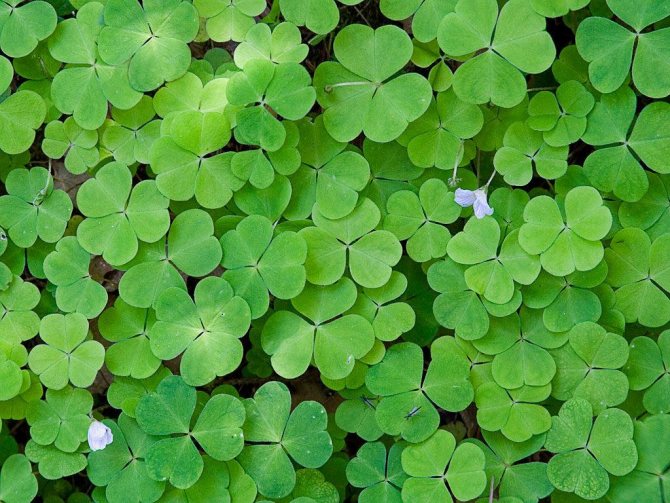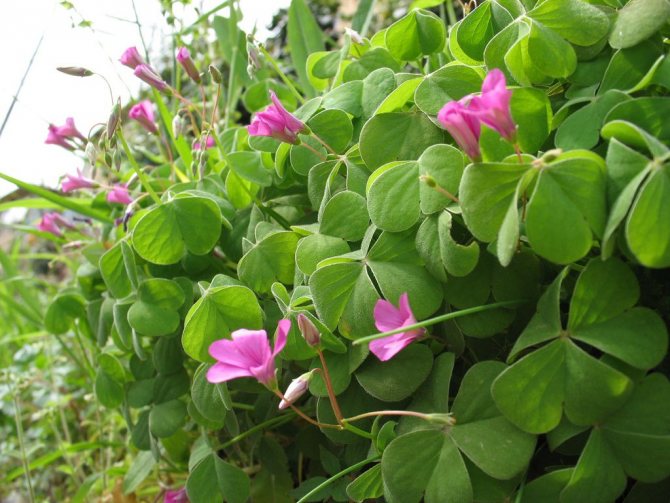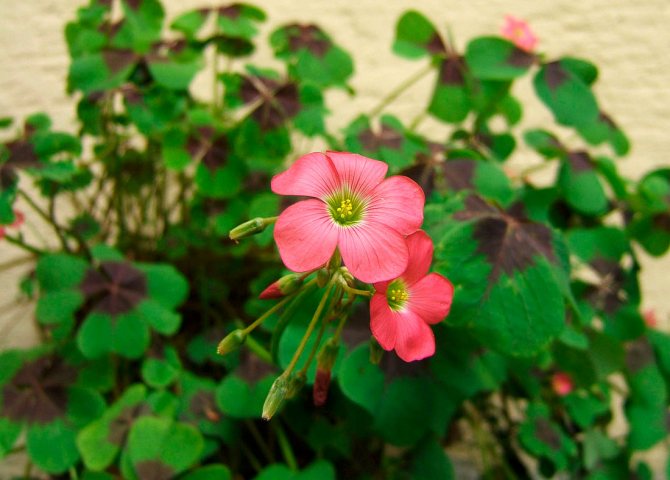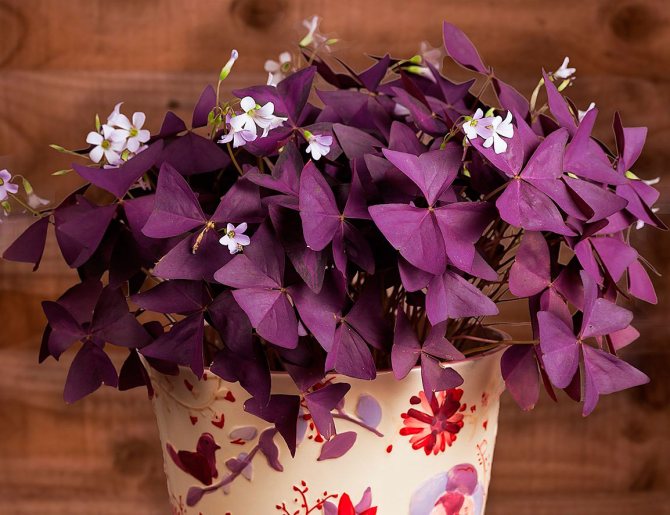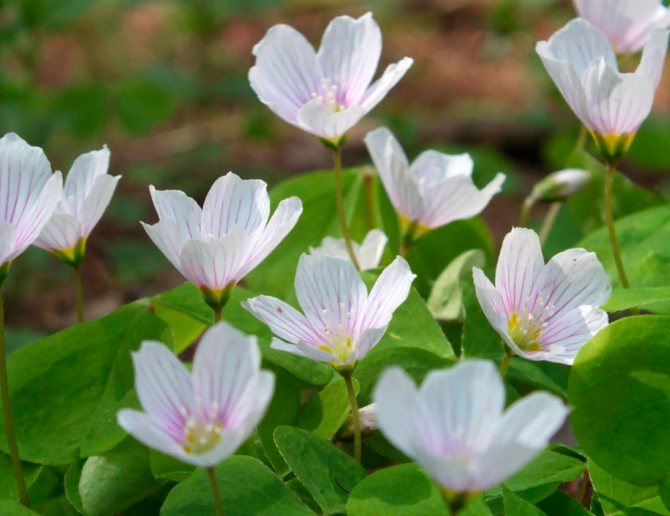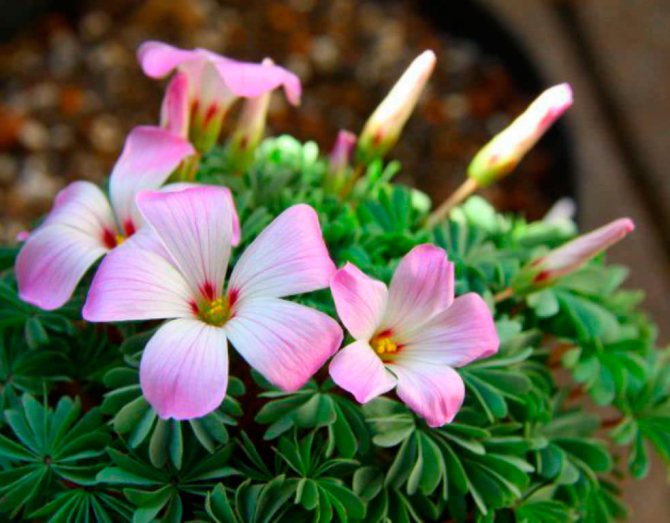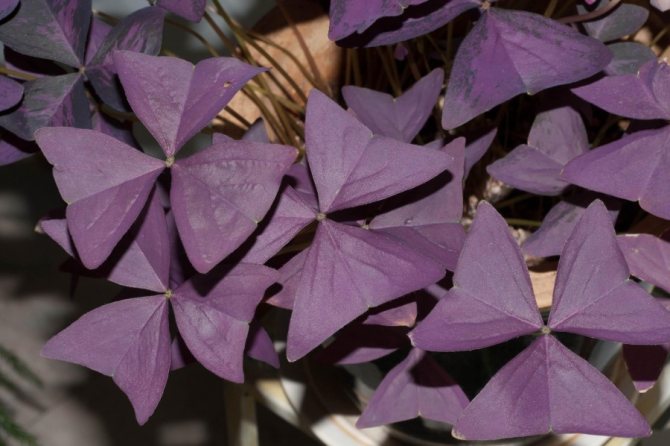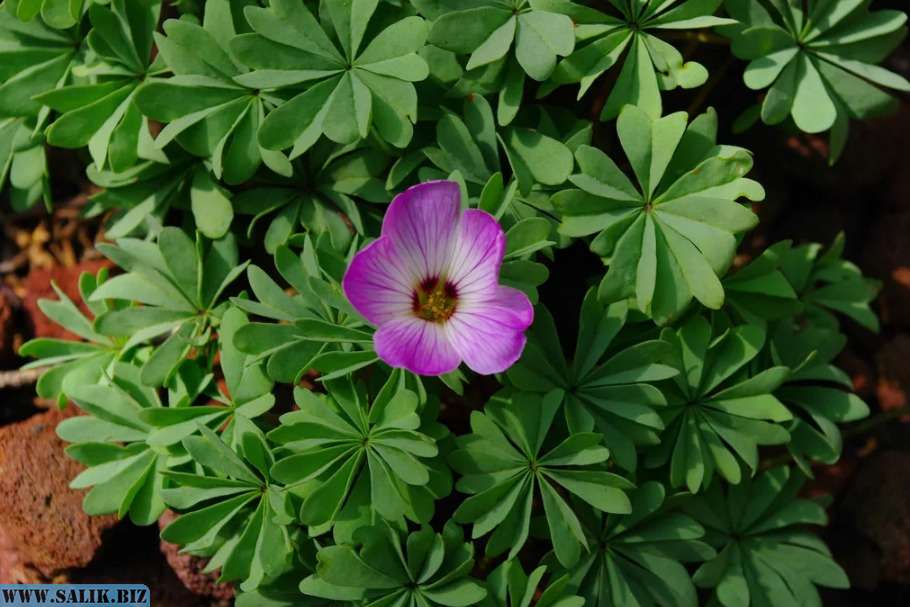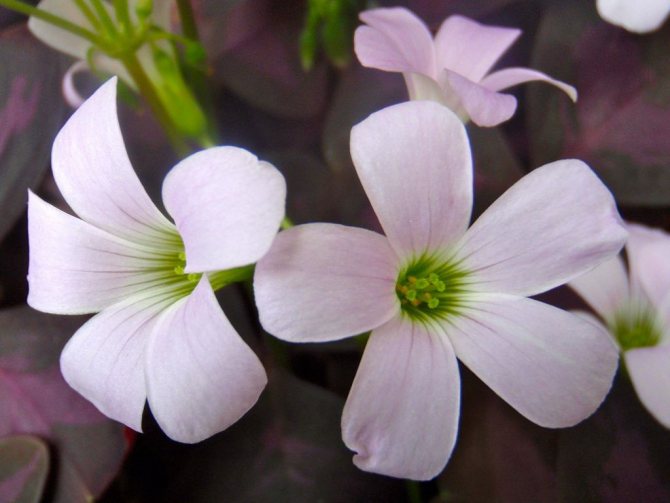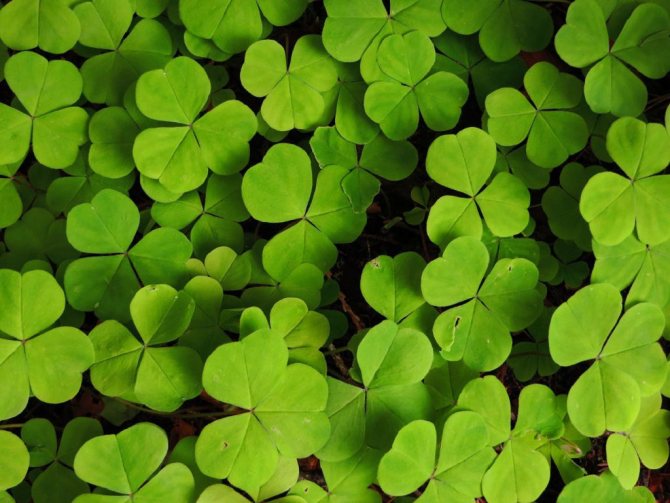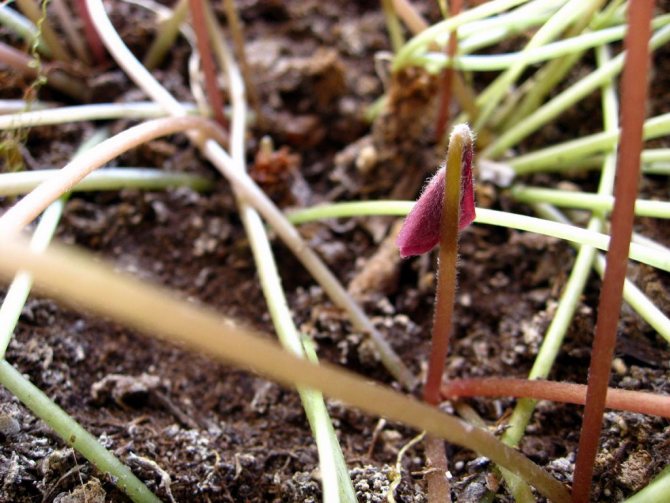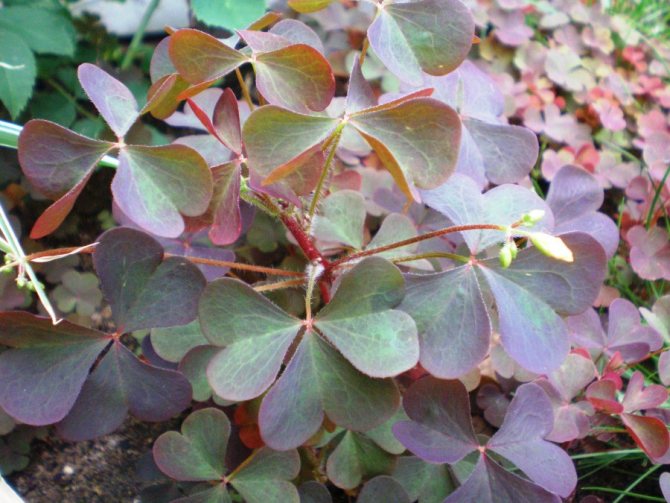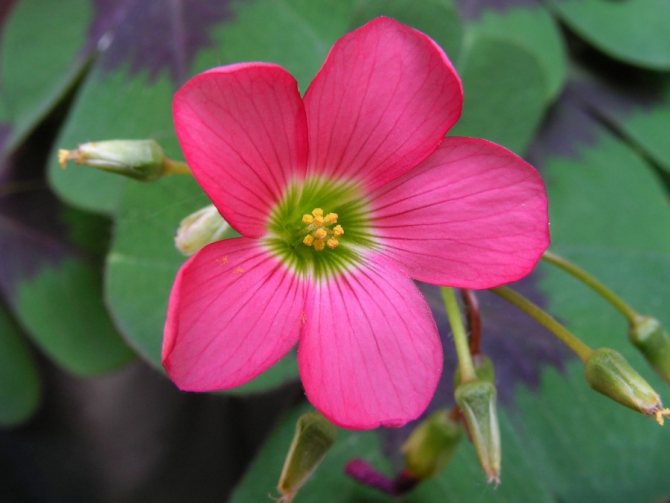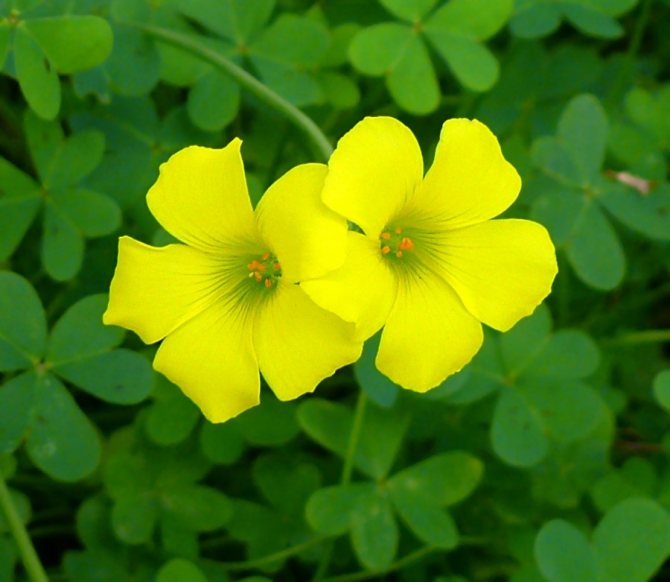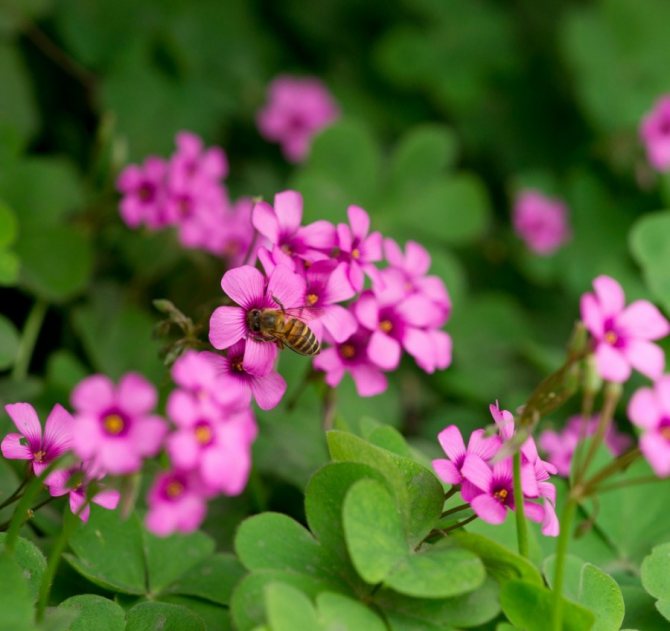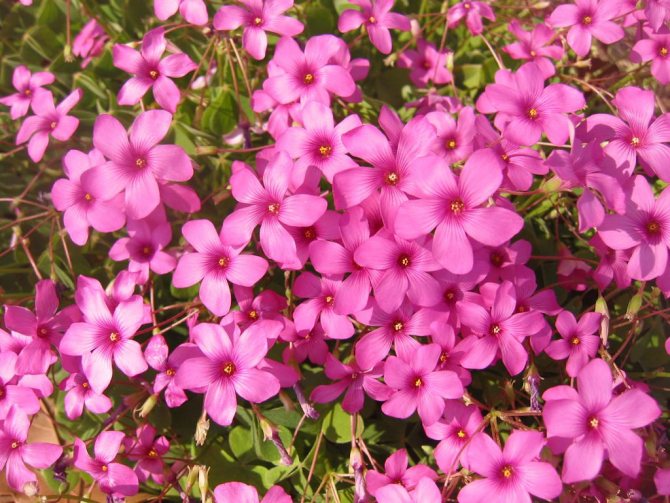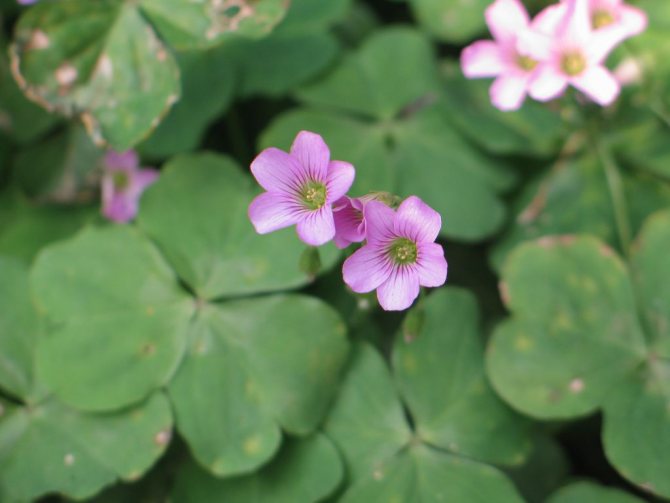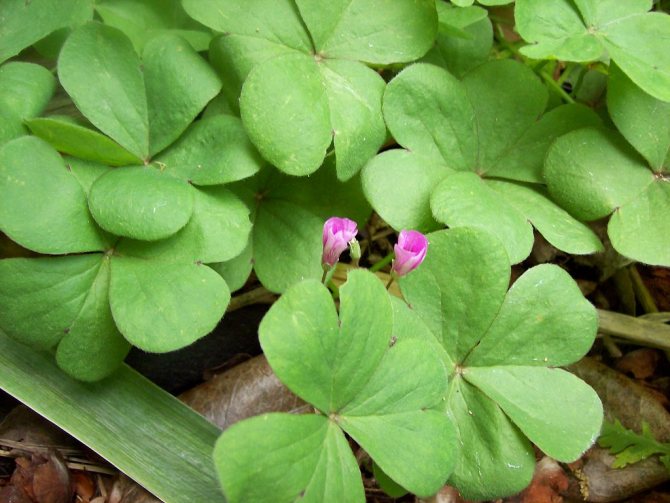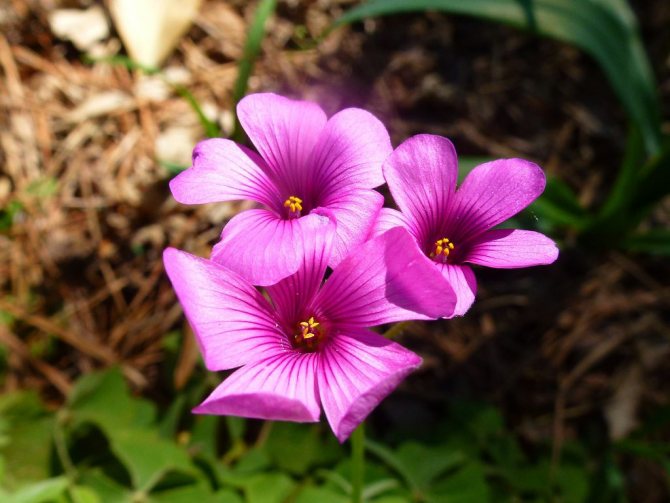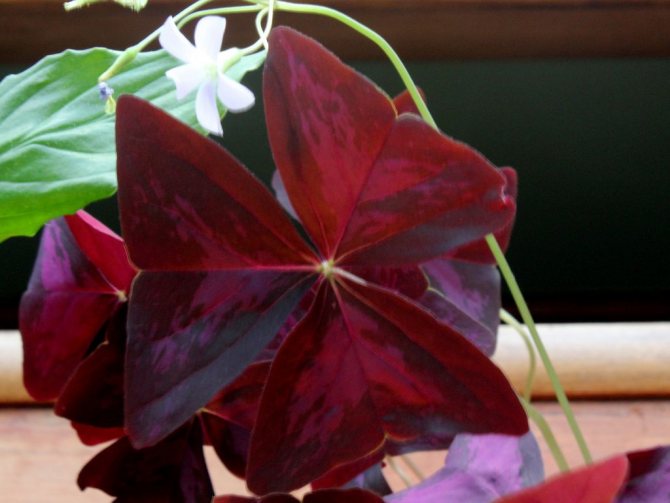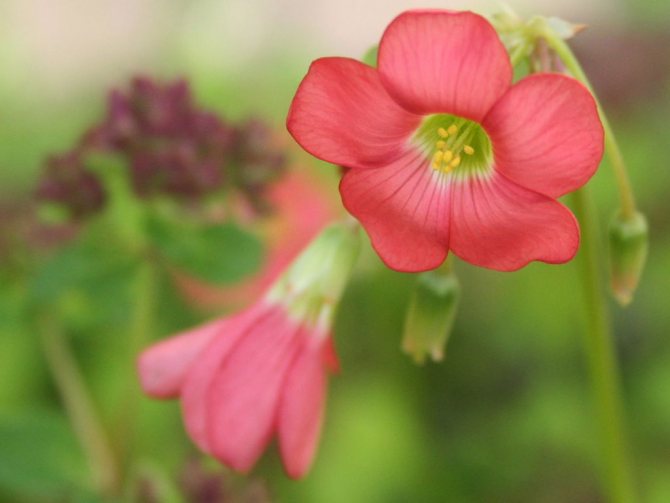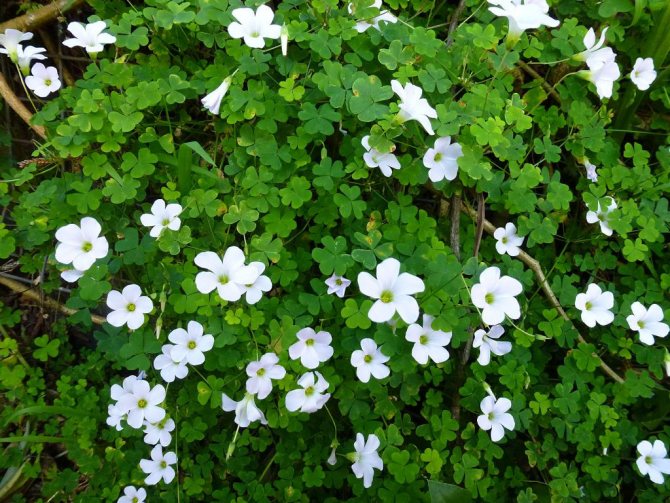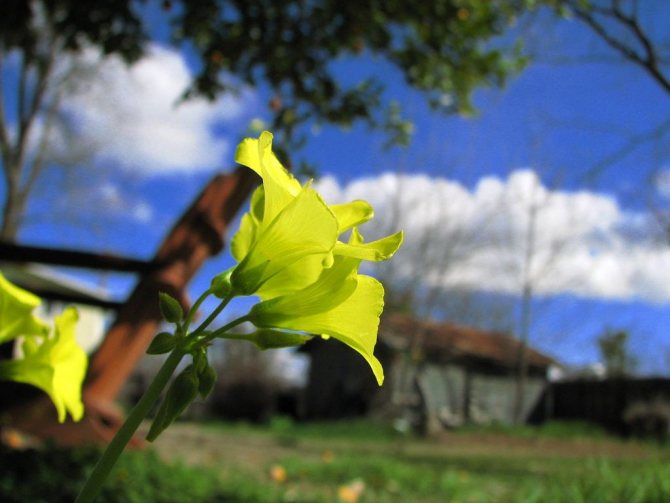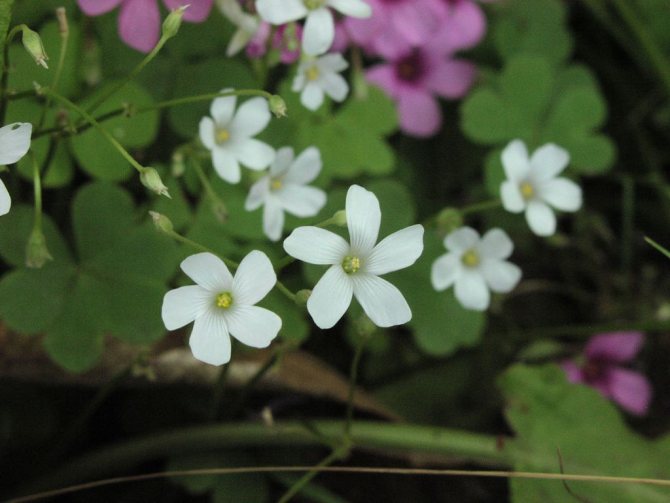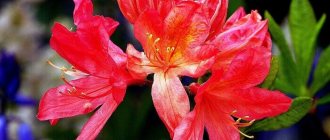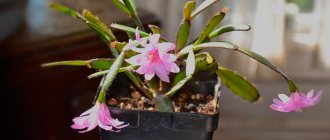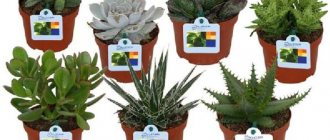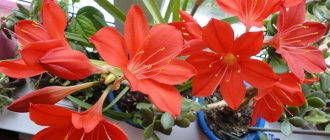Violet oxalis. Photo Oxalis (Oxalis) is an unpretentious perennial herb of the oxalis family, widely used in indoor and garden floriculture. The homeland of the acid is Mexico and the countries of South Africa. In nature, it is often found in temperate regions of Europe, South and Central America.
Oxalis grows rapidly, forming many rosettes in the process of growth, consisting of three- or four-lobed leaves on long petioles. The color of the leaf plates, depending on the variety, varies from emerald green to dark purple.
Be sure to pay attention to the beautiful nightshade plant.
Oxalis blooms with medium-sized single flowers, collected in umbellate inflorescences. Flower petals in different varieties can be colored white, pink, red or yellow.
| High growth rate. |
| Oxalis blooms with medium-sized single flowers. |
| Easy to grow plant. |
| Perennial. |
Useful properties of acid sour
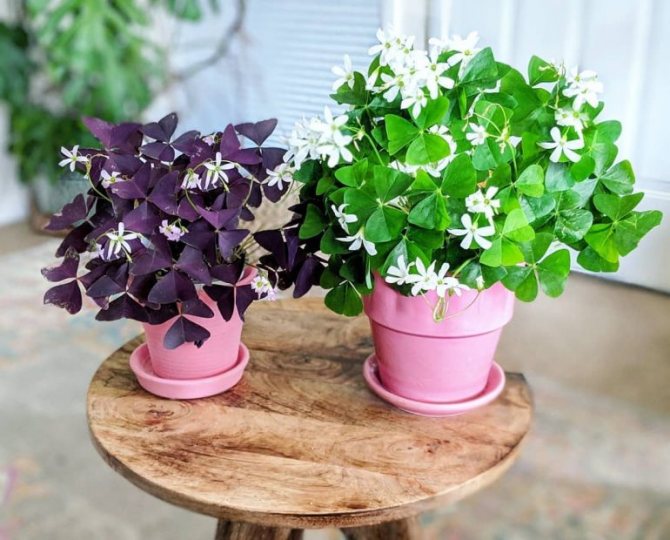
Oxide is familiar to folk medicine as a plant that has a beneficial effect on the human digestive system (stimulates appetite, accelerates metabolic processes, relieves heartburn). Decoctions and infusions from the leaves of the plant are sometimes used to lower blood pressure, treat stomatitis and diathesis.
However, it is important to know that oxalis is a weakly poisonous plant, with prolonged use it can cause nausea, digestive upset, and kidney problems.
Accommodation in the country
More winter-hardy species are luxurious ground cover plants that can form beautiful dense cushions that turn green even under the snow. It is sour trees with delicate white flowers that are able to lighten the shady corner of the garden.
More thermophilic species that do not winter in the open field still manage to become real accents of compositions of semi-shady and shady summer cottages during the season.
Oxalis in a tub with bougainvillea in naked winter, photo by the author
Delicate sour trees are so charming that they are used to decorate the soil in large tubs with fuchsias, citrus fruits, bougainvillea.
Kislitsa: home care. Briefly
| Temperature regime | The most comfortable is + 18- + 20 ° С in summer and about + 15 ° С in winter. |
| Air humidity | Moderate. At home, acid can also tolerate low humidity, provided it is kept cool (at a temperature of + 15- + 18 ° C). |
| Lighting | Dispersed with some direct sunlight in the morning. |
| Watering | In summer - once every 3-5 days with short periods of soil drying, in winter - moderate. |
| Soil for acidic sour | Any loose, fertile, slightly acidic substrate is suitable. |
| Top dressing and fertilization | During the period of active growth, once every 3-4 weeks with a half dose of any soluble fertilizer. |
| Sour acid transplant | Annual for young plants, every 2-3 years for adult specimens. |
| Reproduction | Seeds, dividing the bush, stem cuttings. |
| Features of growing oxalis | On summer days, the plant can be taken out into the fresh air, leaving it on the balcony or in the garden and overnight. Oxalis Depp sheds foliage for the winter, at this time his bulbs are stored in a cool room, periodically watering them little by little so that they do not dry out. |
Ways to protect against predicted consequences
The room assistant has only positive signs.In order for them to take effect and work for the owner as long as possible, you need to pay due attention to the flower. Firstly, oxalis is properly looked after - it is regularly watered, protected from the scorching sun. Secondly, you need to be more often near the plant so that the energy of the flower and the person is intertwined. No additional conspiracies, intricate ways to "activate" the talisman are required - being alive and blooming, it will delight the owner.
Room oxalis is a unique flower. With due attention, it will attract good people and good luck to the owners. Oxalis is absolutely safe energetically and physically. It is enough to provide her with stable conditions, then she will repay with good.
READ Folk omens and beliefs about bird cherry
Caring for sour at home. In detail
Flowering acid
The oxalis plant at home usually blooms throughout the summer. At this time, long thin peduncles regularly appear above the leaves, bearing umbellate inflorescences, combining several medium-sized white, pink, red or yellow flowers.
Temperature regime
Oxalis grows well in a cool room at an air temperature of about + 18 ° С, but higher temperatures are also not terrible for it, it is able to endure heat up to + 25 ° С without loss of decorativeness.
In the cold season, for full wintering, the plant is transferred to a room where the air temperature is + 12- + 15 ° C (only for Depp's acid, warmer conditions are needed - at least + 16 + 18 ° C).
Spraying
Kislitsa has no special requirements for the humidity of the environment; it can grow without harm to health even in the fairly dry air of city apartments.
However, in the hot season, it is better to periodically spray the plant with clean water so that it does not lose its decorative effect.
Lighting
Oxalis is photophilous, but she needs direct sunlight in very limited quantities. The plant is best kept on an east or west windowsill, exposing the flower pot to the sunniest window in the house in the morning. With a critical lack of light, the plant stops blooming and slows down in growth, its leaves stretch out and turn pale.
Watering acid
Home oxalis loves water, but it does not tolerate waterlogged soil: when moisture stagnates at the roots, the plant often rots. In summer, oxalis is watered every 3-5 days with warm, settled water. In autumn and winter, the frequency and volume of watering is reduced to the minimum possible: the soil is moistened little by little, preventing it from drying out.
Pot for sour
In order for the surface root system of the acid plant to develop well, a shallow but wide capacity is selected for the plant.
A thick layer of drainage must be poured onto the bottom of the pot so that moisture does not stagnate at the roots.
Priming
The substrate for growing oxalis is selected light, nutritious, necessarily slightly acidic. The soil mixture can be prepared independently from garden soil, high peat, humus and sand (perlite). The components are taken in a 2: 2: 2: 1 ratio and mixed thoroughly.
Top dressing and fertilization
Caring for acidic sour at home involves regular feeding of the plant with complex mineral compositions during the active growing season. It is enough to apply fertilizers once every 3-4 weeks, while it is recommended to use a half dose of the preparations, so as not to "overfeed" the flower.
Transfer
Young plants grow very quickly therefore need new more spacious pots every year. A transplant of acid, which has reached adulthood, can be carried out less often - once every 2-3 years.
The procedure is best performed in the spring, while the plants have not started to grow actively, by the transfer method, when the old earthen clod is completely preserved when transplanted into a new pot.
Pruning acid
The plant does not need pruning, since oxalis at home, with proper care, forms beautiful compact bushes by itself. To maintain a decorative appearance, you can periodically pluck out too elongated or, on the contrary, short leaves, as well as remove wilted flowers along with peduncles.
Dormant period
The plant goes to rest in winter, the signal for the onset of a dormant period is often the massive drying of the leaves for no apparent reason. For the wintering period, the sour cherry is transferred to a cooler room and its watering is reduced to the minimum necessary. When young shoots begin to appear from the bulbs - the dormant period is over, the plant is returned to a well-lit window.
The nuances of growing decorative non-aggressive oxalis
Bulbs, tubers, delenki (pieces of rhizome with several buds) are planted in spring. Deepen by 2 cm, watered. The first shoots soon appear. Plants are taken out into the garden only when the threat of recurrent frosts has passed (preferably in early June). Rhizome sour trees that overwintered in the ground under a shelter (insulated with a layer of humus, dry foliage) are opened in the spring (the mulching layer is removed).
Oxalis in the garden, photo by the author
You can plant the bulbs immediately in open ground - in May, under a film shelter. It is better to plant sour acid in the fall.
Watering is regular and abundant throughout the season. In autumn, bulbs of thermophilic species (variegated acid, because trapezoidal, or triangular, because four-leafed, or Depp) are dug out of the ground and stored in a cool, dry place. More winter-hardy ones (sour cherry, because nine-leafed, because ferruginous) mulch with humus, dry leaves.
Diseases and pests
Domestic oxalis rarely get sick, it staunchly tolerates not the most favorable growing conditions, such as low air temperatures, too dry air, and insufficient lighting. However, some care errors can still damage the health and attractive appearance of the plant:
- Oxalis rots with excessive watering and stagnation of moisture in the soil. In this case, all damaged areas are immediately removed, after the diseased acid lily it is better to transplant it into a fresh substrate and in the future, carefully monitor compliance with the watering regime.
- Sour leaves are drying when the plant is in the sun for a long time and is not watered at the same time. The dried foliage is removed together with the petioles, after which the optimal irrigation and lighting regime is established.
- Oxalis does not bloom if it is too hot or lacks sunlight. the plant is best kept in a well-lit window, shading from the bright sun.
- The tubers rot if, when planting, they were too buried in the soil or the plant is kept in the cold for a long time. In this case, it is better to transplant acid and transfer it to a warmer room.
- Oxalis grows slowly in low light. Being in the shade, it sometimes even blooms, but cannot form a lush bush.
- Leaf burns appear under the influence of direct sunlight. The plant should be shaded from the hot sun or even removed for a while from an overly lit windowsill.
Pests rarely "encroach" on acid, but sometimes it is still attacked by a mealybug, whitefly, scale insects, spider mites. It is best to deal with them with special insecticides.
Reproduction
Several methods are used to increase the acid sour population. The most popular are described below.
Tubers
Seed planting material in March. Tubers cut off from the mother bush are placed in a common container, lightly sprinkled with soil. Until the roots appear, a constant temperature should be maintained at + 10 ° C, periodically moisten the ground. The first roots will appear after 15-20 days... One month after planting, the temperature should be raised to + 20 ... 25 ° C.
By dividing the roots
During a planned transplantation of acid, you need to carefully, using a sharp knife, divide the mother bush into several parts. Each new plant must be transplanted into an individual cup.
Seeds
You can sow seeds both in separate and in common pots. It is important not to deepen the planting material too much, otherwise the seedlings will have to wait a long time. The containers must be covered with plastic wrap to maintain the internal microclimate until sprouts appear, the humidity must be at a constant level. Viable seeds sprout 10-14 days after sowing.
By cuttings
Using a sharp knife, separate the stalk from the mother bush, plant it in a container with wet sand. After 20 days, the cutting will give roots and will be ready to be transplanted to a permanent location.
Types of homemade sorrel with photos and names
Cup-shaped oxalis (Oxalis bowiei)


A compact variety with small light green trifoliate leaves and graceful pink flowers that rise above the green on long, thin peduncles.
Oxalis Depp, Oxalis deppei
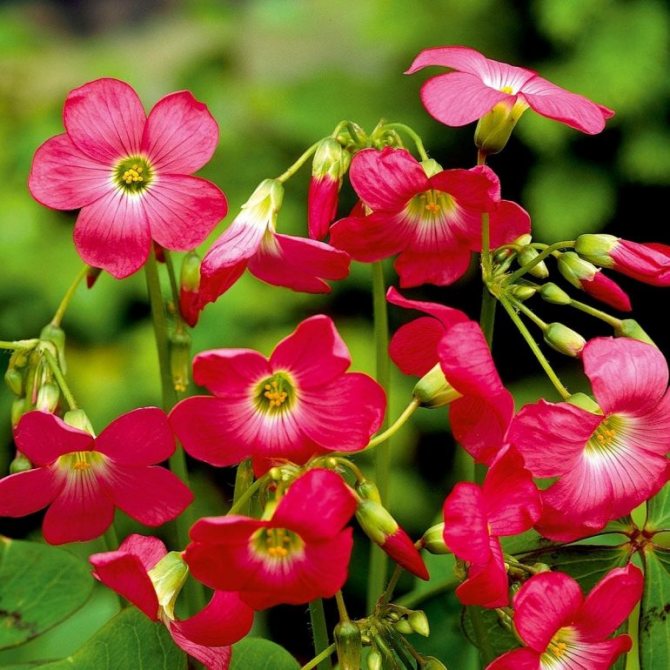

An unusual variety of oxalis, which has small bright scarlet flowers and spectacular four-lobed leaves of a two-color color (maroon core and grassy green edges).
Purple oxalis (Oxalis purpurea)


A miniature plant with bright pink or white flowers and rounded three-lobed leaves of a gray-green hue, the surface of which is slightly pubescent.
Red oxalis (Oxalis rubra)
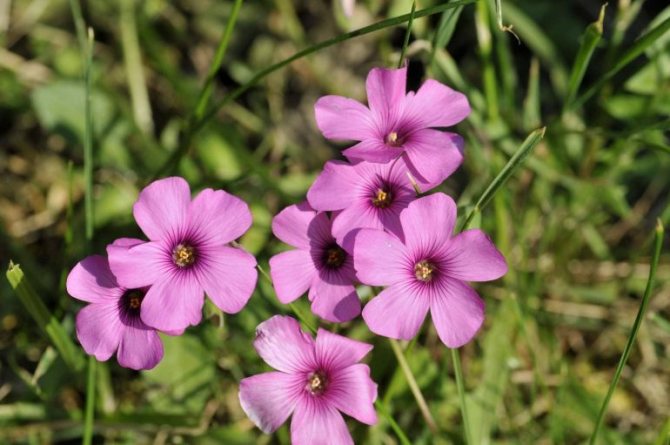

Quite a large variety (up to 40 cm high) with three-lobed fleecy leaves of a juicy green hue and small saturated red or pale pink flowers.
Oxalis ortgiasii


A common variety with medium-sized bright yellow flowers and trifoliate reddish-brown leaves, the segments of which are heart-shaped and pubescent.
Triangular oxalis (Oxalis triangularis) or Regnell's oxalis, purple


A fast growing variety with dark purple three-lobed leaves, the edges of which are decorated with a dark purple border. It blooms with small milky white or pinkish flowers, collected in inflorescences of several pieces.
Ferruginous oxalis (Oxalis adenophylla)
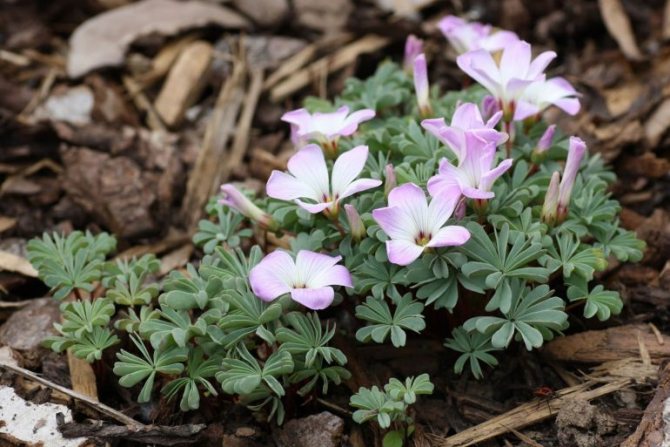

An ornamental ground cover variety with silvery-green feathery leaves, dissected into many fragments, and large pink-lilac flowers, the petals of which are covered with a net of crimson veins, and the core is colored maroon.
Botanical description
Oxalis is a genus of annual or perennial flowering herbs. They have a creeping surface rhizome with tuberous or bulbous growths. Plant height is 15-30 cm. Leaves on petioles up to 20 cm long have a finger-like or trifoliate structure. The length of the leaf is 5-15 cm. The leaf plate tends to fold and fall at night in cloudy weather or under physical influence. The color of the leaves is green and burgundy, monochromatic or two-colored.
Flowering occurs in late spring or early summer and lasts about a month. From the axils of the leaves, a long peduncle grows, which bears one or more buds. Corolla of the correct shape consists of five petals fused into a short tube. They have a rounded, strongly bent outward edge. By analogy with leaves, flowers close at night. The color of the petals is dominated by lilac, white, pink, yellow shades. All flowers are bisexual, prone to self-pollination or insect pollination. In the center of the flower there are 5-10 long filiform stamens and a single ovary. Its column can be longer, shorter, or flush with the stamens.
Fruits are fleshy, oblong seed pods with green leaves. Behind them are small teardrop-shaped seeds with a thick skin. The top layer of the peel contains a lot of sugars to attract ants. It is they who carry the seeds over long distances. After ripening of the sash, the acidic berries open sharply, literally shooting the contents over a long distance.


